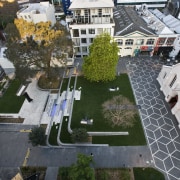heart FULL OF SOUL
The St Patrick's Square upgrade is testament to the design dexterity of Boffa Miskell

St Patrick's Square is a special place in Auckland's CBD home to St Patrick's Cathedral and an area of respite from the hustle and bustle of the city, it is the only significant area of green open space from the mid-city to the waterfront.
A full restoration of the cathedral was completed in 2007 by the Catholic Diocese, and this, combined with the current CBD streets and open spaces programme, presented Auckland City Council with the opportunity to significantly enhance the square and complement the newly restored cathedral.
Boffa Miskell's team of landscape architects led by John Potter designed the upgrade to St Patrick's Square, and co-ordinated the input of the subconsultants who provided civil and structural engineering, traffic engineering, lighting and specialist turf design.
John Fillmore Contracting was responsible for the implementation of the project, with input from numerous subcontractors. The diverse nature of the work and the design gives an indication of the skills of the design company and principal contractor.
Early consultation for St Patrick's Square was carried out by Auckland City Council with existing users of the Square and key stakeholders. This feedback was used to help develop the project's overarching design objectives to celebrate the square's heritage, its religious and cultural significance and its relationship to the cathedral; to create a safe and enjoyable day and night-time environment for people moving through, and spending time in the square; and lastly to retain and enhance the square as an urban oasis and to increase the legibility of entry points making it easier for people to access and enjoy the square.
The challenge from a design perspective was to transform the underutilised open space into a place that offers a number of flexible areas. A highly collaborative approach between Auckland City Council, Boffa Miskell and John Fillmore Contracting resulted in a project team driven by shared goals and with a focus on delivering a distinctive and popular open space within the community.
Several key elements helped create the square's personality. Perhaps the most important is a sense of the natural world, which is infused throughout the project.

The play of water was a strong theme in the design, and several water features are intended to evoke the movement of water in the natural environment. Water forms a physical connection between the Cathedral, Upper Lawn, Terraces and Lower Square.
The hexagonal paving pattern, another notable aspect of the design, is discussed in detail on later pages. It provides a non-directional, unifying ground plane element which serves to anchor the cathedral in the square. Created in basalt and Jura limestone, the hexagonal pattern is a visual reference to the geometry of the roof of the cathedral and reflects the pattern of the tiles on the floor of the nave.
In the Lower Square, paving is used to define the key pedestrian routes encompassing water features, lawn, artworks and hard landscape elements.
The vegetation also has major aesthetic impact from a design perspective existing and introduced trees are used to frame the cathedral, provide dappled shade, and in some cases, seasonal colours.
Lawns were an essential part of making the square child friendly. A tall fescue turf grass was selected for its ability to sustain moderately heavy wear, tolerance of shade and drought, and retention of a green colour during the winter months. A restrained plant palette of low shrubs and groundcover plants ensures that spatial definition and foreground interest is provided, without compromising overall visual integrity. The design increases pedestrian amenity by providing discrete areas for different activities, whilst maintaining this greater aesthetic cohesion.
Secondary seating opportunities respond to the level changes across the site a Guilin limestone is used to provide low retaining walls, steps and terraces that double as informal seating elements.
Artworks by Steve Woodward and Mary-Louise Browne provide significant opportunities for contemplation and enjoyment.

Boffa Miskell is the lead supplier of professional design services for a suite of projects that form part of the wider CBD Streets and Open Spaces Programme an ambitious $157.8 million, 10-year scheme to transform streets and open spaces to the level expected in an international city.
John Fillmore Contracting exhibited a broad skill set to achieve this multifaceted, precision undertaking.
The project was recently awarded a Gold Award and the George Malcolm Supreme Award at the 2010 New Zealand Institute of Landscape Architects Resene Pride of Place Awards.
For details on Boffa Miskell, contact John Potter, phone (09) 358 2526. Website: www.boffamiskell.co.nz.
For details on John Fillmore Contracting, phone (09) 256 2544. Website: www.jfcltd.co.nz.
Story by: Trendsideas
Home kitchen bathroom commercial design



